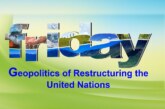
Dr. Arvind Kumar*
We are all running on the road to achieve the 2030 agenda timely, however as of now only 15% of the global targets are on track, and many are regressing. Some experts and policymakers are still ensuring that we can achieve these targets timely and water plays a crucial role in achieving these targets. Water is a connector not a mere sector. It is an economic indicator and plays an important role in ending poverty of all types, food security, decent work for all, climate mitigation and adaptation and many more. The world is currently battling with the formidable crises of, biodiversity loss, pollution and the perils of changing climate. Each of these crises carries its own distinct causes and repercussions, demanding urgent attention and concerted efforts if we are to secure a sustainable and viable future for all. During the event organized by India Water Foundation to commemorate World Water Day 2024 on High level policy dialogue on Stewardship for achieving Water Partnerships for Peace by Transversality Systemic Approach in her chair address Ms. Armida Salsiah Alisjahbana also highlighted that “Clean and abundant water is the basis for a prosperous future for all. Farmers and both rural and urban populations are connected by the water cycle that provides the sustenance and healthy ecosystems that are the lifeblood of our economies and societies.”
The million dollar question is HOW? How to ensure that all get an equitable access to this precious resource? Why is water so central to all the SDGs?
Water emerges as a pivotal element which plays a multifaceted role in our ecosystems, economies and human well-being. However, the availability, quality, and distribution of water are increasingly threatened by the interconnected nature of these crises. To address these issues we need to understand the transversality of water which is systemic, concerted and comprehensive. At the UNEA6 which was held in February in Nariobi it was pledged that the countries would step up efforts to counter climate change, nature and biodiversity loss, and pollution and waste. It is true no single country can address the triple planetary crisis on its own and we need these types of pledges not just in rhetoric but in practice to drive the global momentum we need to build a more sustainable planet. Similarly at the G7 countries meeting in April 2024 the issues on environment, climate and energy were discussed and it was agreed to set up a ‘Water Coalition’ to tackle the global water crisis. Water is fundamental for life and cross-sectoral by nature and the water crisis is being exacerbated by the impacts of climate change. Water and its sustainable management are fundamental to tackle the triple global crisis — climate change crisis, pollution, biodiversity loss — in an integrated manner.
Transversality Systems approach?
Water systems exist within a bigger system of interactions covering food, energy, health, education, sustainable diets, and other areas. It has a deep connection with livelihood, health, food security, hunger, participation, and cooperation. A systems perspective on water-resources management is now emerging as a way to capture these interlinkages. These multiple dimensions of water have placed it at the crossroads of systems thinking that aims at sustainability. One of the missing links with the SDGs is how they can be made to work together in synergy, rather than in competition. Meeting the food security goals infringes on water goals. Meeting the water goals infringes on the energy and other goals. This has created divergence in progress towards the goals. Hence, we must look at end points and at integrative outcomes, integrative metrics that allow convergence and not divergence. Since 2014, World Economic Forum has listed water scarcity as a global systemic risk of high concern. In its Global Risk Report of 2024 water continues to be referenced as a primary global risk trigger. Future water scarcity will grow due to drivers such as population and economic growth, increased demand for animal products and biofuels, and climate change.

The current approach to water management is largely sectorally siloed and has proven unsuccessful in holistically addressing the resource allocation crisis. It fails to predict emerging hotspots and regions with impending resource allocation challenges. Nor does the current approach consider the impact of or on multiple sectors and stakeholders. It fails to consider associated tradeoffs between resource allocations in given scenarios. It lacks the analytical methodology to identify holistic solutions and capitalize on synergies between multiple sectors. A comprehensive systems approach to these objectives is essential for effective, integrated water resource management and decision-making. Such a systems approach includes these important components: Integration of the environment (ecology) and socio-economic issues, Integration of water use, functions, and values, Integration of water, energy, ecology, and health systems, Integration of all stakeholders in the multiple decision-making processes. To be effective, such an approach necessitates commitment from all sectors, effective collaboration, multi-sectoral coordination, and awareness of the water resource demands of all stakeholders. Water is an increasingly essential component of geopolitics and hydrodiplomacy. Nothing significant can be achieved without political will from the highest levels of decision making.
Cross-sectoral integration can be a catalyst for sustainable development. A multidimensional model with a triple bottom line of environment, economy, and social dimensions of water distribution emerges and includes water as it relates to and is impacted by energy, food, health, industry, climate change, municipalities, education, peace, equity, and access. Indeed, bi- and multi-lateral connections comprise the pillars of the system. “Systems thinking” means putting all topics at the same level rather than focusing on individual connections.
Way Forward
The implementing levers for the proposed new vision for water management include technological solutions which are either for water sector (i.e. desalination) or in the energy sector (i.e. reducing the water footprint in the energy production or utilization) or in agriculture technologies (i.e. dryland dryfarming technologies or high efficiency indoor production systems). In any specific case, these technological solutions are levers that we need to use to bridge the water gap. These include policies and incentives that could promote certain solutions that are more sustainable in the long run. We need education and awareness for changing behavior. These include behavioural and anthropological changes that could happen through education to increase awareness and to change behaviour towards utilization of these resources (for instance, reducing waste in water, energy, food, and other resources) to promote ecosystem health and human health or to adopt sustainable consumption patterns. A system level paradigm to delivering water to society is needed to engage these stakeholders. Solutions of the water challenge need not be water specific. Solutions must mobilize multiple stakeholders, from public, private, civil society, and local community. Solutions must use innovative policy to catalyze solutions and create new public-private partnerships. Solutions must be multi-sectoral. Not less, solutions must be holistic, Incorporating water and energy and food production and consumption. The systems approach presented does not stop at the interlinkages or the hotspot and trade-off analysis. It is used as a catalyst to create a platform for informed dialogue to help reach these potential solutions.
*Editor, Focus Global Reporter




